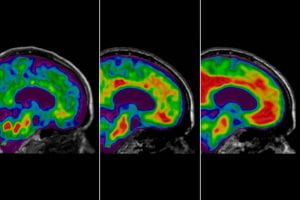Expanding knowledge of other proteins associated with Alzheimer’s disease and other neurodegenerative diseases.
Mission
Establish a world-leading center utilizing mass spectrometry and other novel methods to discover neurodegenerative biomarkers in Alzheimer’s disease (AD) and related disorders.
The center aims to…
- Better understand the causes of Alzheimer’s disease and other neurodegenerative disorders, primarily through aggregation of proteins in the brain and the role of these proteins in the disease process.
- Develop and validate biomarkers for both diagnosis and prognosis.
- Discover and implement simple and effective diagnostic tests for Alzheimer’s disease and related dementias.
- Accelerate the development of new treatments for AD and related diseases.
Updates
- First two SILQ Center faculty members joined, pilot & discovery projects ongoing, installation of major equipment established for first two phases
- Major funds raised in partnership with The Foundation for BJH and the Tracy Family
- Space for Center secured (new Neuroscience Research Building currently under construction)
- The SILQ Center moved into WashU’s new Neuroscience Research Building and is getting settled in the new space.
- Chihiro Sato, PhD Joins the center in the role of assistant director. Chihiro has been working and collaborating with the SILQ center since it’s creation and brings a wealth of knowledge and experience to this new role.
News
New blood tests can help diagnose Alzheimer’s — but some aren’t as accurate as others (Links to an external site)
Now that there are drugs to treat Alzheimer’s, blood tests to detect it will likely become an attractive, low-cost option to decide who can get treatment. Some tests are more accurate than others.
WashU, Eisai form drug discovery collaboration (Links to an external site)
Washington University School of Medicine in St. Louis and the pharmaceutical company Eisai Co. Ltd., headquartered in Japan, have formed a research collaboration aimed at developing new treatments for Alzheimer’s disease, Parkinson’s disease and other neurodegenerative conditions. The two organizations previously have partnered on Alzheimer’s clinical trials, and the new alliance combines their complementary efforts to identify and validate biomarkers and drug targets for a range of neurodegenerative conditions, with a goal of developing new drugs for the benefit of patients worldwide.
Expected outcomes of the Neuro SILQ Center
- Better understanding of the causes and progression of neurodegenerative diseases (e.g. Alzheimer’s, Parkinson’s, Lou Gehrig’s/ALS, etc.)
- Discover new mechanisms of disease to enable specific treatment development for neurological diseases
- Discover new biomarkers to identify disease before nervous system damage occurs (e.g. amyloid and tau blood test)
- Personalized medicine – to identify the specific path causing disease in each individual
- Internal growth of novel approaches
- Investment from external investigators and groups
- Development of methods for commercial spin-off
Impact of our partnerships
- A combined blood tau and β-amyloid test can be used to detect Alzheimer’s disease amyloid plaques and tau tangles in individuals before symptom onset and predict when individuals may have symptom onset.
- The combined blood tau and β-amyloid test can accelerate ongoing and future clinical trials, especially prevention trials, to speed drug discovery for Alzheimer’s disease prevention and treatments.
- When effective drugs are found, the combined blood tau and β-amyloid test can be used to screen millions of people in the general public to identify who is at risk for Alzheimer’s disease and start treatments even before memory loss and brain damage begins.
- Future phases:
- Discover novel biomarkers to improve patient care and improve treatment options.
- Determine the link between amyloid plaques and tangle formation to develop specific treatments (Personalized Medicine).
- Develop novel approaches and assays for other disease pathologies such as Parkinson’s disease, Frontotemporal Dementia, ALS/Lou Gehrig’s disease.

